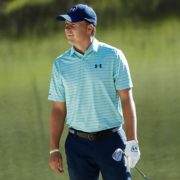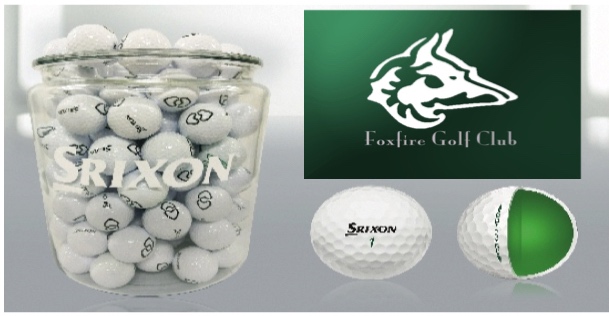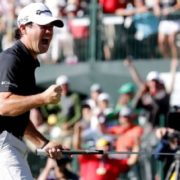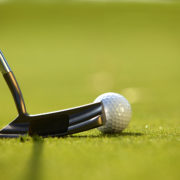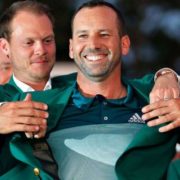Posts
UPDATE! Our Ball Fitting has been postponed due to weather. More info soon!
Foxfire is proud to host 2 Ball Fitting Sessions with Top Rated Suppliers in May & June. These are First Come, First Serve, so mark your Calendars Today! 🗓 Both are Open to Public.
Events:
SRIXON BALL FITTING DAY!
SATURDAY, MAY 27th
12 Noon to 3 PM, Open to Public!
CALLAWAY BALL FITTING DAY!
SUNDAY, JUNE 11th
12 Noon to 3 PM, Open to Public!
“Please take the time to see for yourself how having the right golf ball HELPS your Game of Golf!” – Vince
Brian Harman wins Wells Fargo Championship; Dustin Johnson denied 4th straight victory
WILMINGTON, N.C. — Brian Harman made a 30-foot birdie putt on the final hole Sunday to win the Wells Fargo Championship and deny Dustin Johnsonthe chance at his fourth straight victory.
Johnson, in his return from a freak back injury that knocked the world’s No. 1 player out of the Masters, went from making the cut on the number to a 67-67 weekend at Eagle Point and appeared headed for a playoff with Harman and Pat Perez.
Harman won it with a birdie-birdie finish, none bigger than the par-5 18th.
After going so long on his second shot that he needed relief from behind a corporate tent, Harman hit a heavy chip that barely got onto the green. From just under 30 feet away, the putt dropped into the center of the cup and set off a wild celebration, with Harman repeatedly shaking his fists and leaping to share a hard hug with his caddie, Scott Tway.
“It’s surreal,” Harman said. “I three-putted that 15th hole, knew it was going to be tough to birdie those last couple. But I stuck to my game plan and just did it. Did the best I could.”
And it was just enough.
Johnson was playing for the first time in six weeks because of his slip down the stairs the day before the Masters that led to him pulling out. A quick start allowed him to lurk behind the leaders all day, and he holed a 15-foot birdie putt on the 18th that gave him a share of the lead.
Then, he was alone in the lead when others started to stumble — Perez with a double-bogey on No. 14, Harman with the three-putt bogey on the 15th, and Patrick Reed, the 54-hole leader who made four bogeys in a six-hole stretch on the back nine.
Perez bounced back strong with birdies on the 16th and smart play on the 18th, taking on the water that runs along the right side of the hole and laying up to trust his short game. He hit a pitch up the slope to 4 feet for birdie and a 68.
Perez headed upstairs to the clubhouse to hang out with Johnson, and when Harman left himself a long birdie chance on the 18th, they were gearing up for a playoff.
And then they weren’t.
Jon Rahm of Spain, one of five players who had at least a share of the lead on the back nine, was the last player with a chance if he were to make eagle on the final hole, as he did when he won at Torrey Pines in January. But his approach sailed over the green, and his chip never had a chance.
Rahm closed with a par for a 71 to finish alone in fourth.
Reed shot 40 on the back nine for a 75 and fell out of the top 10. He played in the final group with Alex Noren of Sweden, who closed with a 77.
Harman’s only other victory was the John Deere Classic in 2014 that sent him to the British Open. Besides other perks of winning, this victory gets him back to the Masters, which he has played only one time.
Johnson watched someone else leave with the trophy for the first time since Feb. 12, when he finished third behind Jordan Spieth at the AT&T Pebble Beach Pro-Am. Johnson ran off three straight victories against the strongest fields of the year to date, including a pair of World Golf Championships.
And then came the mishap at the Masters, when he suffered a deep bruise on his lower back from the tumble down the stairs while wearing only socks. This is the first time he played in six weeks, and while there were signs of rust, he looked like the same old Johnson over the weekend as he made up ground.
“I didn’t have a lot of time off, so I didn’t really know what to expect this week because I didn’t really get to practice leading into this tournament, either,” Johnson said. “Not much has changed. The first couple days I didn’t play that great, but really played nicely on Saturday and Sunday, and so I’m happy with where the game is going into next week.”
Johnson had three birdies in six holes to lurk behind the leaders the rest of the day, and he kept pace with birdies on the 12th and 13th. His second shot on the par-5 12th hit the front of the green and was rolling back toward the water, stopping 8 inches away. He got up-and-down for birdie, the kind of break winners need.
Harman had other ideas.
Sergio Garcia outlasts Justin Rose to claim Masters, first major
Sergio Garcia won his first major title on Sunday by making a birdie on the first hole of a sudden-death playoff to beat Justin Rose at the Masters.
Playing Augusta National’s 18th hole in the playoff, Rose sent his tee shot into the trees to the right and was forced to punch out close to where Garcia’s tee shot ended up in the fairway.
Garcia’s approach came within 10 feet, and Rose followed to within 14. Rose missed the putt. Garcia stepped up and rimmed in a birdie putt for the victory.
Both players missed birdie putts on 18 in regulation, with Garcia’s a real dagger. He was 5 relatively flat feet away from his first major victory. Rose had slipped his putt past the hole from 7 feet.
Rose led by a stroke heading to 17, but he hit his approach shot into the greenside bunker and couldn’t get up and down. His bogey put both golfers at 9 under.
Garcia rallied to tie Rose for the lead with three holes remaining. He birdied the 14th hole and followed with an eagle on the par-5 15th after his approach shot caught the flagstick and stopped 15 feet away. The putt barely trickled into the cup for his first eagle in 452 holes at Augusta National.
Rose managed to make a birdie, but it wasn’t enough to keep the lead.
He reclaimed the lead at the 16th hole with a brilliant tee shot, which set up an 8-foot birdie putt that pushed his score to 10 under.
Garcia’s tee shot was even closer, curling back toward the pond before stopping 6 feet away. But the Spaniard pulled the putt and settled for a par that left him one stroke behind with two holes remaining.
Sergio Garcia, Thomas Pieters, Charley Hoffman share lead with Rickie Fowler
AUGUSTA, Ga. — Rickie Fowler finally got to the top of the leaderboard in a major and didn’t have much of a view.
Right next to him was Charley Hoffman, playing in the final group going into the weekend at the Masters for the second time in three years. Sergio Garciaknew the score when no one else did and had his first share of the lead in his 19th time playing Augusta National. Not to be overlooked was Thomas Pietersof Belgium, a real threat to become the first Masters rookie since 1979 to leave with a green jacket.
And those were just the co-leaders in the largest 36-hole logjam at the Masters in 44 years.
Even more daunting were the players lined up behind them — Jordan Spiethand Phil Mickelson among four Masters champions, Olympic gold medalist Justin Rose, Spanish rookie sensation Jon Rahm and Rory McIlroy, missing only this major for the career Grand Slam.
“It’s going to be a fun weekend,” Fowler said after a 5-under 67, the best score of another wind-swept day. “We’re going to see a lot of good golf and battle it out.”
Two days of survival gives way to a shootout among some of golf’s biggest stars.
In conditions just as demanding as the opening round, Fowler holed out a bunker shot for eagle on his second hole, quickly moved into the lead pack and secured his spot in a share of the lead with a tricky birdie putt from the collar of the 16th green.
Garcia, playing his 70th consecutive major and still looking for that first victory to define an otherwise strong career, wasn’t the least bit bothered by seeing the wrong score for him on a leaderboard behind the 13th green when a penalty for a lost ball was mistakenly attributed to him. He bounced back from a bogey behind the 13th green by firing a 3-iron across the water and into the wind to the 15th green for a two-putt birdie. He shot a 69.
Pieters moved to the top by hitting off the pine straw and over a tributary of Rae’s Creek to 12 feet for eagle on No. 13, and he followed with a wedge to 4 feet for birdie on the 14th to shoot 68. Hoffman lost his four-shot lead in 11 holes before he steadied himself the rest of the way and limited the damage to a 75.
The leaders were at 4-under 140.
Hoffman will be in the final group going into the weekend at the Masters for the second time in three years, with one big difference. Two years ago, Hoffman was five shots behind Spieth in what turned out to be a runaway for the young Texan.
This time, the Masters appears to be up for grabs.
The wind began to subside as the pines cast long shadows across the course late in the afternoon, and the forecast is close to perfection for the rest of the weekend, with mild temperatures and hardly any wind.
That won’t make it any less exhausting, not with 15 players separated by only five shots.
The last time there was a four-way tie for the lead at the halfway point of the Masters was in 1973, when Bob Dickson, Gay Brewer, J.C. Snead and Tommy Aaron were tied at 3-under 141. Aaron went on to claim his only green jacket.
Hoffman had a chance to keep his distance until he ran off five bogeys in a six-hole stretch, including a three-putt from 4 feet at the par-5 eighth.
“Everybody was talking about how great that round was yesterday, but it was pretty easy to me — making putts, hitting good, solid golf shots,” Hoffman said. “Today I think I sort of felt how hard it was for everybody else in this wind when you got out of position.”
Garcia only really got out of position on the scoreboard.
His tee shot on No. 10 clipped a tree and shot back into the fairway, while Shane Lowry also hit a tree and couldn’t find it. Both were wearing dark sweaters during the search, and the scorers were confused with who lost the ball. Garcia made bogey, dropping him to 3 under. A few holes later, however, it was changed to 1 under on the scoreboard, and Garcia pointed to the board behind the 13th green.
It eventually was fixed, though that was of no concern to the 37-year-old Spaniard.
“The most important thing is I knew where I stood,” Garcia said.
And he knows the score that everyone talks about — 70 majors as a pro without a victory, and enough close calls to make him wonder if he’ll ever get it done.
Spieth, undone by a quadruple bogey in the opening round, started slowly and finished strong with birdies on the 16th and 18th for a 69. Adam Scott, the 2013 Masters champion, also had a 69 and joined Spieth at 144.
“We’re in a position now where we can go out there and win this thing and certainly make a run,” Spieth said. “So that right there just kind of gives me chills, because after yesterday I was really disappointed in being 10 shots off the lead.”
And right there with them was Mickelson, who can become the oldest Masters champion. The 46-year-old Mickelson was one shot behind until he sputtered down the stretch with three bogeys and two par saves over his last five holes for a 73.
“If I can have a good putting weekend, I’m going to have a good chance,” he said.
Him and everyone else.
How Tiger Woods, in his heyday, made golf cool by transcending it
Maybe it was those 350-yard drives and spontaneous, exuberant fist pumps.
Perhaps it was the big smile, athletic build and the brilliant marketing campaign that showed him doing everything from juggling golf balls with his club to walking on water. Then, too, there was that name — Tiger — and the fact he looked different than all the other golfers he was beating so regularly.
Whatever it was, Tiger Woods has been as much a cultural comet in professional golf as a victorious one. From the time he turned pro in 1996, and even past his last major victory at the U.S. Open in 2008, Woods drew mores eyes to him and his sport than any other golfer ever. In his prime, Woods turned tournaments into must-watch events, even for those who’d never teed up a golf ball.
He was compelling, a perfect blend of talent and charisma suited for a growing American diversity and the digital age. TV ratings, galleries and prize money all increased significantly. People had to watch. Woods dragged golf — a sport most Americans have never played — into the Land of Cool.
Among professional athletes for most of the early 2000s, Woods ranked with basketball icon Michael Jordan at the top of the Q Score, which rates popularity and marketing appeal. In 2008, Forbes ranked Woods No. 2 on its annual Celebrity 100 list, based on fame and money. Only Oprah Winfrey was higher.
Plus, he was making cultural as well as sports history. In 1997 at just 21, he stormed to a win at the Masters, shooting a record score and living up to years of hype. That it came at Augusta National, where African-Americans hadn’t been allowed to play until 1975, put him in a special place. The attention just kept coming, with 13 other major victories — including four straight — and 79 total wins on tour.
“Tiger embodied a kind of modern cool that golf hadn’t seen before,” said Orin Starn, a professor of cultural anthropology at Duke University and author of the book “The Passion of Tiger Woods.” “This was to a certain degree, and still is, a bland, vanilla sport played by anonymous white guys who all dress the same and look the same. So to have this charismatic, young African-American-Asian-American hybrid figure bursting onto the scene made huge news.”
Rick Schloss, the former longtime media director of the annual PGA Tour event at Torrey Pines in San Diego, recalled how the galleries swelled when Woods came to the tour, attracting a younger element interested in one thing: Tiger.
“They’d go there to watch him,” Schloss said. “They don’t know what else is going on. They’ve got their Ugg boots on, the hats on backwards, they’ve got a craft beer, and they know he’s cool.”
In 2001, after he won four straight majors, Americans polled by Gallup named him as the nation’s No. 1 athlete. His favorability rating was on a par with the likes of Jordan, John Glenn, Colin Powell and Pope John Paul II.
Yet Woods slipped from that perch in 2009, when his off-the-course life turned upside down with a personal scandal that led to divorce. He took a leave from golf for several months. He lost sponsorships. When he returned, he wasn’t the same. His smile, swing and putting stroke were diminished.
His last tour win came in 2013, and he failed to reach the weekend at his only two starts in 2017, missing the cut at the Farmers Insurance Open in late January and withdrawing due to injury from a European Tour event after one round in Dubai a week later. He hasn’t played since.
Prior to that, Woods missed nearly a year and a half because of a back injury, although he did play the Hero World Challenge, an unofficial PGA Tour event that he hosts, in December.
In his absence, golf’s attendance and TV ratings suffered.
Now 41, Woods has skipped three 2017 tournaments (the Genesis Open, Honda Classic and Arnold Palmer Invitational) that he typically plays each year, and his next move remains unknown. He even WD’d from a news conference prior to the Genesis Open, which is run by the Tiger Woods Foundation.
Woods hasn’t given up hope of making what would surely be a dramatic return at next week’s Masters. Starn, for one, is looking forward to seeing Woods back inside the ropes.
Said Starn: “There’s always interest in a comeback story in America.”
TIGER’S CELEBRITY PRECEDED HIM to the PGA Tour. He was a child prodigy, a standout at Stanford and a six-time USGA national champion (three U.S. Junior Amateurs and three U.S. Amateurs). He and other celebrities from the sports and entertainment world were like magnets, attracting one another. He lived in a different, more star-studded world than golf’s other top players.
Woods appeared on the sidelines at NFL and basketball games. He played golf with Jordan, Charles Barkley and Tony Romo. He hung with Mark Cuban, Michael Phelps, Jon Bon Jovi, Sting and Will Ferrell. Each year, the Tiger Jam fundraiser for his Tiger Woods Foundation in Las Vegas delivered the celebs. It all brought more attention to golf and the tournaments he played.
Chris Zimmerman, the former director of advertising for Nike and then the company’s general manager for golf, was there when Woods turned pro and signed a $40 million sponsorship deal with the company. From the outset, he said, those around Woods were intent on making him more than just the best golfer of his generation.
“From day one, they had interest in what Tiger could be as an athlete, but also as a brand,” said Zimmerman, now the president and CEO of business operations for the St. Louis Blues. “That’s a tall order for a 21-year-old coming out of a few years at Stanford. But he had been on a path toward greatness from an early age, and certainly both his dad and the people around him, they were very clear that they believed Tiger Woods could be a great brand, much in the same way that Michael Jordan had been.”
The first Nike TV commercials in 1996 to introduce Woods to viewers were “Hello, World” and “I am Tiger Woods.” Each told stories. The first was about his commitment to golf and his road to the tour. The second, his roots and connection to a new, diverse generation. Zimmerman says the intent was never to make Tiger cool — above the rest — but to show his respect for the game and help Nike launch its golf equipment business.
When Woods’ style and personality meshed with his wins and the acceptance of Nike’s products, the ad campaign helped catapult him into the Jordan realm.
“That’s where the magic is,” Zimmerman said.
The most memorable commercial was itself enchanting, a 1999 spot in which Woods juggled a ball on a clubface for nearly 30 seconds while switching hands, going between his legs and behind his back before popping the ball into the air and knocking it down the driving range with a baseball swing.
While many top golfers can do the same thing, Average Joe and Jane watching at home didn’t know that. Tiger, it seemed, could do anything.
“It was an exceptionally successful commercial,” Zimmerman said. “It just fascinated people. They wanted to know if it was real, had he really done that.”
Those commercials helped him vault from athlete to cultural icon, according to Donna Barbie, professor of humanities and communication at Embry-Riddle Aeronautical University in Florida and editor of the book “The Tiger Woods Phenomenon,” a collection of essays.
“His dad and his companies were marketing geniuses,” Barbie said. “Has there ever been a golfer who was so marketed as Tiger Woods?”
Barbie, who studies cultural phenomena, said Woods was a “change agent” for golf, bringing it further into the mainstream and boosting TV ratings, attendance and earnings. Even the golf video game that bore his name was popular with young gamers.
“They would never have dreamed of playing golf, of all things, in some software, electronic format if it hadn’t been for Tiger Woods,” she said. “I can guarantee that.”
His presence on tour was a signal that golf had changed and that younger players would have to change, too, to compete.
“It’s not old men in weird plaid pants anymore,” Barbie said, laughing. “It’s young, vibrant athletes who can show their athleticism.”
The fact Woods was built like an athlete — and trained like one — made him stand out among fellow golfers, Barbie contended. So did his heritage, his talent and his bearing. He wasn’t the everyman, eye-contact, hand-shaking Arnold Palmer who brought fans to the game in the 1950s and ’60s. Woods was more focused and aloof on course, making him both “cool and compelling.”
“He was not one of the people,” Barbie said. “But he caused people to want to participate and witness greatness. … They love Tiger Woods because he was above it, because he was on the pedestal. We really love to look up to people who are larger than life.”
Barbie, a lifelong golfer, often followed Woods on the PGA Tour, watching his fans as much as she watched him. They always expected to see him to do the unexpected. Usually, he did.
She recalled Woods one year at the Arnold Palmer Invitational at Bay Hill contemplating whether to go for a green over water or lay up.
“He’s holding a wood and everyone’s going, ‘Yeah, he’s going to go for it,'” she said. “And then he puts the wood away and brings out the iron, and there was a groan by the gallery, just a groan, like, ‘Really? You’re going to disappoint us?’ And then he takes out the wood and goes for it and gets it, and everybody is ecstatic.
“That’s what cool is.”
CHRIS RILEY PLAYED AGAINST Woods as a junior and in college before both turned pro in 1996. While Woods went straight to the PGA Tour, Riley got there in 1999, eventually advancing to No. 22 in the Official World Golf Ranking and playing with Woods and Team USA in the 2004 Ryder Cup.
Riley said Woods “transcended the game” and helped lift the image of golf, which was “nerdy” when he played as a boy but now is considered a “cooler game.”
“No doubt,” Riley said. “At sports bars now, people will watch golf, especially if Tiger is playing. Even if he’s not playing. But pre-1996, nobody watched golf unless you were a golfer.”
Plus, Riley said, Woods impacted the sport with his dedication to fitness, prompting other golfers change their training habits to keep up.
“You don’t see the guys anymore, the Tim Herrons, going to have a beer or a cocktail after the round,” he said, referring to the tour veteran nicknamed “Lumpy.” “They go to the gym to get a massage, work with their trainer.”
It’s not hard to see how Woods’ influence on the game has rubbed off on the current wave of top talent led by Rory McIlroy, Dustin Johnson, Jason Day, Jordan Spieth and Justin Thomas. However, Tiger’s impact off the course might be only as effective as his game. As his play has gone downhill, so has the sport’s popularity as recreational activity.
The equipment business Nike had built around Woods suffered, too, and last year the company announced it would no longer sell golf clubs, balls and bags.
“Tell me if I’m wrong, but I think he made it cool to watch and not really to play,” Riley said.
Starn sees the same thing. Tiger’s magnetism was a boon to the tour, but it might not have the lasting effect the sport had anticipated. Without Woods in recent years, Starn said the tour lacks a dynamic sense of excitement.
“But I do think Tiger generated a kind of excitement around golf that was unprecedented,” Starn said.
Latest News
 Foxfire Golf Course UpdateAugust 11, 2020 - 7:09 pm
Foxfire Golf Course UpdateAugust 11, 2020 - 7:09 pm Major questions about Tiger, Brooks and more with Masters one month awayMarch 10, 2020 - 8:52 pm
Major questions about Tiger, Brooks and more with Masters one month awayMarch 10, 2020 - 8:52 pm How often should you replace your irons?September 29, 2019 - 10:09 am
How often should you replace your irons?September 29, 2019 - 10:09 am Gary Woodland’s journey to U.S. Open championJune 17, 2019 - 5:37 am
Gary Woodland’s journey to U.S. Open championJune 17, 2019 - 5:37 am Cantlay (64) Rallies From 4 Back To Win MemorialJune 3, 2019 - 12:42 pm
Cantlay (64) Rallies From 4 Back To Win MemorialJune 3, 2019 - 12:42 pm
Promotions
Club Events
Business Hours
Contact Us:
Foxfire Golf Club
389 Canterbury Road
Commercial Point, OH. 43116
Our Location
389 Canterbury Road
Commercial Point, OH. 43116
Pro Shop
(614) 224-3694


